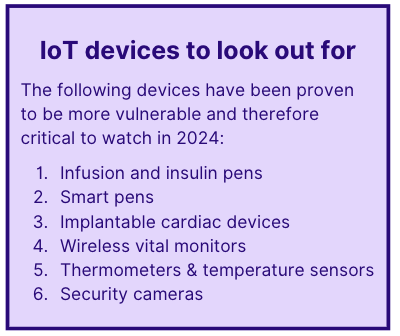
As we enter the new year, the healthcare industry continues to face the critical challenge of balancing technological innovation with cybersecurity. The integration of digital solutions has revolutionised patient care, streamlined operations, and improved medical research. However, these advancements also bring unprecedented cybersecurity threats that jeopardise patient data, medical records, and healthcare systems.
Research has shown there to be a significant increase in cyber attacks on the healthcare sector. In 2023, the industry experienced an average of 1,684 attacks per week, a 22% rise from the previous year, making it the third most targeted industry. With the average cost of an attack reaching £8 million, it is vital for healthcare companies and their suppliers to prioritise risk mitigation. We have identified five key areas that healthcare businesses should focus on in the coming year:
Ransomware Attacks
Internet of Things (IoT) Vulnerabilities
Insider Threats and Human Error
Supply Chain Vulnerabilities
Evolving Regulatory Landscape
1. Ransomware Attacks
Overview:
Ransomware attacks involve the infiltration of malicious software that encrypts a healthcare organisation’s data, making it inaccessible until a ransom is paid to the attacker. Over recent years these attacks have become more and more sophisticated, with threat actors utilising advanced techniques to exploit vulnerabilities in outdated software and employing social engineering tactics. Threat actors are always looking for new innovative ways to spread malware into systems and therefore we will see lots of new approaches in 2024.
Implications:
The consequences of a successful ransomware attack on healthcare systems are severe. Hospitals and clinics may face disruptions in critical services, impeding patient care. The encrypted medical records could compromise patient safety, as healthcare professionals grapple with accessing vital information during emergencies. Moreover, the financial burden of ransom payments and the costs associated with system recovery further amplify the impact on healthcare organisations.
Mitigation Strategies:
- Regularly update and patch software to address vulnerabilities.
- Conduct regular cybersecurity training for staff to recognise and avoid phishing attempts.
- Implement robust backup and recovery mechanisms to minimise the impact of a ransomware attack.
- Invest in advanced threat detection and response systems to identify and mitigate attacks in real-time.
2. Internet of Things (IoT) Vulnerabilities
Overview:
The healthcare industry has wholeheartedly adopted IoT devices to elevate patient monitoring, treatment, and healthcare delivery. Yet, the interconnectedness of these devices presents a formidable cybersecurity challenge. The reliance on IoT devices within healthcare amplifies the attack surface for cybercriminals, enabling them to exploit vulnerabilities, gain unauthorised access to sensitive information, or even disrupt critical medical equipment.
Implications:

The infiltration of IoT devices poses significant risks in healthcare, including unauthorised access to patient data which could lead to identity theft or fraud. Additionally, malicious actors may exploit vulnerabilities to manipulate medical devices, putting patient safety at grave risk. Given the escalating reliance on IoT in healthcare, the potential consequences of successful cyber attacks on these devices are becoming increasingly severe.
Mitigation Strategies:
- Conduct thorough security assessments of IoT devices before integration into the network.
- Keep track of IoT devices with an asset repository.
- Implement network segmentation to isolate IoT devices from critical healthcare systems.
- Regularly update and patch firmware on IoT devices to address security vulnerabilities.
- Enforce strong authentication mechanisms for accessing and controlling IoT devices.
3. Insider Threats and Human Error
Overview:
Despite the astonishing progress in technology, human error continues to play a substantial role in cybersecurity incidents. Within the healthcare sector, insider threats can arise when employees unwittingly succumb to phishing attacks, accidentally disclose sensitive information, or unknowingly download malicious files. Even in 2024, the risk of insider threats lingers, underscoring the imperative for comprehensive training initiatives and stringent access controls.
Implications:
Unauthorised access, data breaches, and the compromise of patient records are potential outcomes of insider threats. Cybercriminals can exploit the unintentional actions of employees, such as clicking on malicious links or sharing login credentials. The repercussions encompass reputational damage, legal consequences, and a loss of patient trust.
Mitigation Strategies:
- Conduct regular cybersecurity training to educate employees about phishing and social engineering tactics.
- Implement multi-factor authentication to enhance login security.
- Establish strict access controls, limiting employees’ access to sensitive information based on job roles.
- Monitor user activities and network traffic for unusual or suspicious behaviour.
4. Supply Chain Vulnerabilities
Overview:
Healthcare organisations depend on a sophisticated network of suppliers, service providers, and partners. While this interconnected ecosystem boosts efficiency, it also exposes vulnerabilities to cyber threats. Last year we saw a rise in the number of supply chain cyber attacks and this number is set to continue rising into 2024. Threat actors exploit weaknesses within the suppliers operating within a supply chain to illicitly access vital systems. Therefore, organisations must continuously evaluate and bolster the cybersecurity stance of third-party vendors.
Implications:
A compromised supply chain security can result in unauthorised access to patient data, the introduction of malicious software, or disruptions in healthcare service delivery. The interconnectedness of the supply chain magnifies the potential consequences of a breach, impacting multiple organisations within the healthcare ecosystem.
Mitigation Strategies:
- Implement thorough vetting processes for third-party vendors, assessing their cybersecurity practices.
- Establish contractual agreements that mandate adherence to cybersecurity standards.
- Regularly audit and monitor the security practices of supply chain partners.
- Encourage the adoption of cybersecurity best practices throughout the healthcare supply chain.
5. Evolving Regulatory Landscape
Overview:
As the healthcare industry responds to emerging cyber threats, regulatory frameworks are evolving to enforce more robust data protection measures. Organisations must remain vigilant to ensure compliance with increasingly stringent regulations, such as the Health Insurance Portability and Accountability Act (HIPAA) and the General Data Protection Regulation (GDPR). Failing to meet these compliance standards not only exposes healthcare providers to legal consequences but also undermines the trust patients place in the security of their sensitive medical information. It is imperative for organisations to prioritise data protection and uphold patient confidentiality in this ever-changing landscape.
Implications:
Failure to comply with healthcare regulations can have serious repercussions, such as legal penalties, financial fines, and damage to reputation. Patients rightfully expect healthcare providers to handle their sensitive data with the utmost care, and adherence to regulatory standards is vital for maintaining trust.
Mitigation Strategies:
- Continuous Compliance Monitoring: Implement systems for continuous monitoring of compliance with healthcare regulations, ensuring that any deviations are promptly addressed.
- Legal and Compliance Teams Collaboration: Foster collaboration between legal, compliance, and cybersecurity teams to stay abreast of regulatory changes and ensure alignment with evolving standards.
- Data Encryption and Access Controls: Implement robust data encryption protocols and access controls to safeguard patient information in accordance with regulatory requirements.
Conclusion
The ever-evolving landscape of cybersecurity threats in the healthcare industry demands a holistic and proactive approach. Organisations need to stay ahead of cybercriminals by employing cutting-edge technologies, fostering a culture of cybersecurity awareness, and complying with regulatory standards. As we move further reliant on technology to drive practice, healthcare providers must prioritise the security and integrity of patient data to ensure the trust and well-being of those they serve. By implementing the outlined mitigation strategies and remaining vigilant in the face of emerging threats, the healthcare industry can navigate the intricate challenges posed by cybersecurity and continue to deliver high-quality, secure, and patient-centric care.
Protect your business with Arx Alliance
The Arx platform is unique. Our approach is collaborative rather than prescriptive. We give you the tools and the framework to create robust, secure supply chains in a way that is effective, and cuts through the noise and jargon of a complex industry.
Over time, through a guided step-by-step process, we can help you identify and mitigate risks inside your own organisation, and collaborate with your suppliers to create robust, secure supply chain relationships.
Arx provides your firm and suppliers with a suite of tools:
- Visibility of the organisation’s attack surfaces
- Efficient control of cyber policies and standards
- Central place for managing standards and controls
- Continuous monitoring of all touch points
- Situational awareness for all tiers of supply chain
- Risk scored suppliers to highlight weak links

